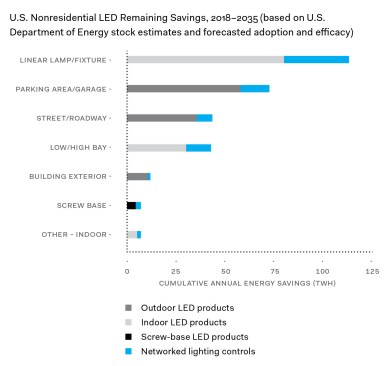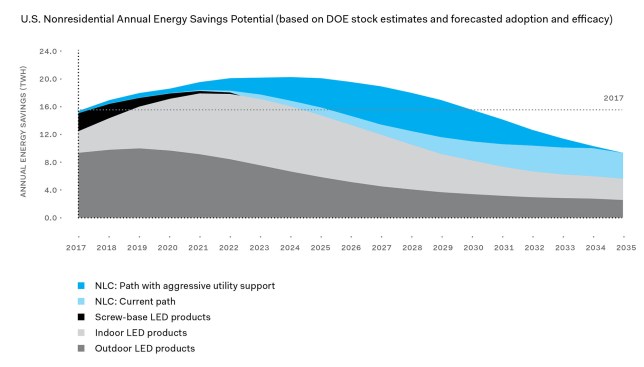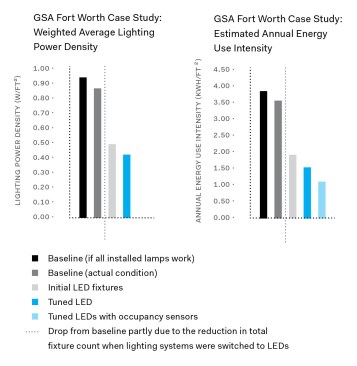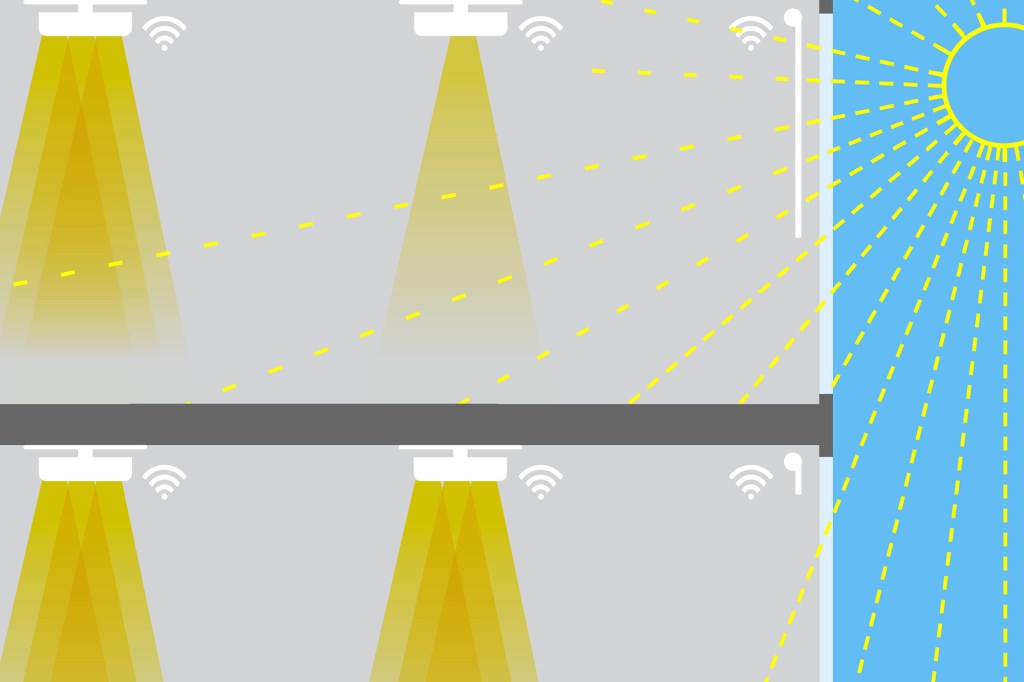It feels good to be in control. When it comes to the occupant experience in a building, lighting control systems can provide some of that satisfaction with the added benefits of increasing the flexibility of a space and reducing energy consumption.
Though lighting controls have been around for decades, they have recently evolved to become more sophisticated and complex. Networked lighting controls (NLC), in particular, have the potential to reduce energy usage as much as the switch from conventional sources to solid-state lighting, or LEDs.
“Lighting is the ‘poster technology’ for energy efficiency,” says Tina Halfpenny, executive director of the DesignLights Consortium (DLC), a nonprofit organization based in Medford, Mass., that advocates for the adoption of high-performance commercial lighting solutions. “You’re in a different scenario when it comes to controls because of the added benefits—and there are many beyond energy efficiency.”

Source: “Energy Savings Potential of DLC Commercial Lighting and Networked Lighting Controls, the DesignLights Consortium, July 2018
Controls Grow Up
The simplest lighting controls are the on/off switch and dimmer, followed by timers, motion sensors, occupancy sensors, and photosensors. Advances in control technologies include daylight sensors and color tuning, which adjusts the color temperature of white light. Controls can be operated manually, automatically, or both.
NLCs can tie these technologies together to maximize their effectiveness, providing programmable lighting control for a floor, building, or even an entire campus. Wired or wireless, networked components may include luminaires, controls, sensors, drivers, software, and an online or app-based user interface. NLCs can talk to other building systems, such as mechanical, and be managed from a single dashboard as part of an overall building management system. They also allow for programmability, such as the zoning and rezoning of spaces, and can track system performance.
Put simply, NLCs can provide the right amount of light when and where it is needed. As such, they can also help a project comply with energy codes (such as California’s Title 24), achieve sustainability certification, and enhance occupant well-being and productivity.
Perhaps the most compelling argument for NLCs is one based on economics. A 2018 DLC report found that NLCs used with LED fixtures can reduce energy usage by as much as 47%. Improved working environments can increase employee productivity and subsequently a business’s operating efficiency and revenue. Furthermore, data collected by a network can reveal insights into a facility that help reduce operating costs and also improve logistics, such as conference room scheduling and equipment tracking in facilities such as hospitals and airports.

Source: “Energy Savings Potential of DLC Commercial Lighting and Networked Lighting Controls, the DesignLights Consortium, July 2018
Making the Leap
Despite their potential, the adoption of NLCs has been limited. Reasons include their initial cost; complexity to specify, install, and operate; lack of standardization among products (all system components must be able to communicate to each other utilizing compatible protocols); and the task of training operations and maintenance staff. According to the DLC, fewer than 10% of new construction projects and 1% of lighting retrofit projects are estimated to use the technology. However, the U.S. Department of Energy estimates that more than a third of installed luminaires in commercial buildings will have network connectivity by 2035.
First costs, Halfpenny acknowledges, “are still quite high.” The challenge, she says, is convincing owners and end users to invest in NLCs during new construction rather than wait until a retrofit, when installing the system will be more expensive.
In order to help specifiers choose the best products, the DLC has created a qualified list of NLC products for interior environments. As a prerequisite to inclusion on the list, each system must incorporate occupancy sensing, zoning, daylight harvesting, high-end trim, and energy monitoring. Daylight harvesting describes the capability to automate the operation of lighting or other equipment based on the amount of daylight or ambient light present. High-end trim is the capability to set the maximum output of an individual luminaire or a group of them to less than the source’s maximum state—while still delivering the necessary light levels—at the time of installation or commissioning.
“You can get a view of the different capabilities of qualified systems, and that’s what we’re finding is speaking to the end user,” Halfpenny says. “Non-energy benefits—such as conference room scheduling, improved ambient conditions, and increased flexibility of spatial utilization—can be more motivating for people than energy savings.”
For an architect or lighting designer, knowing the array of product features available may help them find one that appeals to their clients and bolsters the case for implementing NLCs.

Felix Mizioznikov
The U.S. General Services Administration commissioned the Department of Energy’s Pacific Northwest National Laboratory to evaluate advanced LED lighting controls at the Fritz G. Lanham Federal Office Building, in Fort Worth, Texas.
Evidence in Numbers
In support of its Total Workplace initiative, as well as its move toward open floor plans, the U.S. General Services Administration commissioned the DOE’s Pacific Northwest National Laboratory to evaluate five different LED systems with advanced lighting controls in 76,000 square feet of mostly open office space at a large GSA office building in Fort Worth, Texas.
In its November 2018 report, PNNL noted a 43% savings in lighting energy from the advanced lighting controls on top of the savings achieved by switching from fluorescent fixtures to LEDs. Half of that 43% was attributed to tuning the light levels, and the other half to optimizing the performance of occupancy controls and sensors. NLCs, the PNNL study found, are most likely to be cost-effective in open offices in which occupants engage in different tasks due to the system’s ability to sense occupants and tune light levels.
“Without the benefit of lighting controls, many of our tenants found the LEDs to be just too bright,” noted Frank Campagna, energy project manager of the GSA Greater Southwest Region, in the report. “Once we tuned the new fixtures, people were much happier.”
The controls were also more cost-effective when integrated into the fixture by the original equipment manufacturer rather than retrofitted in the field.
The DLC and the DOE have also completed a series of lighting demonstration projects. At a three-story, 30,500-square-foot medical office in Avon, Conn., fluorescent lighting fixtures were retrofitted with LEDs, wireless controls, and advanced sensor options that allowed light levels to be customized. The switch to LEDs alone saved the site more than 29% of its baseline energy consumption for lighting. With the addition of advanced occupancy sensing and daylighting controls, the savings jumped an additional 33% for a total of 62% savings, equivalent to 69,000 kilowatt-hours (or $8,200) annually. The lighting system, including the fixtures and controls, cost $92,500 total, resulting in a payback period of less than seven years.
And, importantly, 79% of occupants were satisfied with the new light level controls, and 86% were satisfied with the overall lighting.

Source: “Evaluation of Advanced Lighting Control Systems in a Working Office Environment, Pacific Northwest National Laboratory, November 2018
Next Up for NLCs
In this era of rapid advancements, building owners are justifiably concerned about technology obsolescence. By knowing what lies ahead for NLCs, architects may be able to help address their clients’ questions.
Several manufacturers foresee advances in data gathering and analysis to improve the built environment. Javier Carracedo, a Dornbirn, Austria–based segment manager of IoT (internet of things) solutions for Tridonic, expects the sensing capabilities of lighting products to grow and include temperature, air quality, and noise detection. “NLCs also now have the capability to process and analyze harvested data, opening the door to services that both improve building operating expenses and the well-being of its inhabitants,” he says.
“The future of NLCs must incorporate control of both electric light and natural light via a dynamic daylight management system,” says Matt Ochs, an Allentown, Pa.–based product management director with Lutron Electronics. “Not only will this holistic approach to light control increase energy savings, but it also enhances the occupant experience by providing greater access to views and natural light throughout the space.”
Ochs believes that information collected by NLC sensors will also inform mobile apps now in development to give occupants additional control and customization options of their workspaces. “As building owners adopt these apps designed to enhance workforce productivity and engagement, lighting controls will have to integrate seamlessly,” he says. “Plug-and-play integration will be the key to broad adoption of any lighting control platform.”
